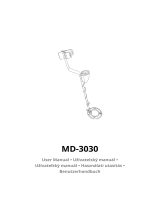
CSR1 20 VELLEMAN
b. Detectiebereik
De CSR1 is heel goed voor zoeken op grote diepte, maar de bodemsoort kan het detectiebereik ernstig beperken.
Het detectiebereik is afhankelijk van de grootte van het voorwerp, het tijdstip waarop het begraven werd, en het soort
grond waarin het begraven is. Vaste grondsoorten leveren de beste resultaten op. Muntstukken kunnen ook op grote
diepte teruggevonden worden als ze al een tijdje begraven zijn en gereageerd hebben met de zouten in de grond,
waardoor ze voor de detector groter lijken. De slechtste grond voor metaaldetectie is rulle of pas omgewoelde grond.
Voorwerpen die nog niet zo lang begraven zijn, zijn eveneens moeilijk op te sporen. Ter informatie: 90% van alle
kunstvoorwerpen worden gevonden op dieptes tot ongeveer 20 cm.
c. Grootte en diepte van een voorwerp bepalen
Eens de gebruiker zijn toestel goed kent, zal hij de afmetingen, de vorm en de diepte van een voorwerp heel goed
kunnen vaststellen voor hij begint te graven.
De techniek kunt u leren door de radaruitlezing en de geluidssignalen van de detector aandachtig te bestuderen.
Luister altijd naar de specifieke kenmerken van elk signaal, bepaal de zone waarin u een signaal krijgt, en probeer
het voorwerp te “omlijnen” voor u begint te graven.
Nadat u het voorwerp hebt opgegraven vergelijkt u de grootte, de vorm, de diepte en de positie in de bodem met de
gegevens die u eerder uit het signaal had afgeleid. Naarmate u meer signalen grondig heeft geanalyseerd, zult u
leren het verborgen voorwerp te “lezen” voor u het opgraaft.
d. Het belang van een correct gebruik
Op schattenjacht gaan, kan een voordelige en lonende hobby zijn, als u geduldig en toegewijd tewerk gaat. De tijd
die u besteedt aan het opsporen van een plaats die de moeite waard is, kan verloren tijd zijn als u overhaast of op de
verkeerde manier te werk gaat. Om het beste resultaat te halen, is het belangrijk de plaats op voorhand te bepalen
vóór u werkelijk gaat zoeken.
De tactiek wordt bepaald door het soort plaats - u kunt beter een klein gebied zorgvuldig doorzoeken, dan op goed
geluk te zoeken in een grotere zone. Als deze plaats echter te ver is afgelegen om meerdere keren terug te kunnen
gaan, kunt u beter een zo groot mogelijk stuk van het terrein doorzoeken, en tegelijkertijd de beste plaats bepalen
voor een diepgaander onderzoek.
Uiteraard wordt het succes van uw zoektocht niet alleen door de detector bepaald. Er is altijd nog de persoon die de
detector bedient en die moet de juiste aanpak, houding en techniek bezitten om de beste resultaten te halen. Teveel
beginners onderschatten het belang van vooraf plannen en opzoeken voor ze hun detector ter plaatse gaan
gebruiken, en missen geduld en techniek tijdens het zoeken zelf.
Een succesvolle zoektocht begint met opzoekingwerk dat u uitvoert een tijdje vóór u van start gaat met zoeken. De
reikwijdte en de grondigheid van de opzoekingen zijn van groot belang voor het welslagen van de hele onderneming.
Probeer zoveel mogelijk te weten te komen over de plaatselijke geschiedenis en aardrijkskunde.
Probeer altijd uit te vissen waar mensen de laatste honderd jaar zoal samenkwamen. Wat waren hun gewoonten en
bezigheden? Waar gaven ze hun geld uit? Waar bewaarden ze hun geld? Het antwoord op deze vragen valt niet
noodzakelijk samen met oude Romeinse sites. Het houdt evenmin altijd verband met mysterieuze verhalen over
schatten en potten vol goud. Vaak gaat het om bescheiden, onopvallende plaatsen, zoals openbare wandelpaden,
vroegere tolbarrières, oude huizen enzovoort.
Nadat u de plaats bepaald hebt, moet u een hele dag uittrekken voor de zoektocht, van vroeg in de ochtend tot aan
de vooravond. Zorg ervoor dat u al het nodige materiaal bij heeft. Controleer de detector voor u vertrekt en neem
altijd reservebatterijen mee. U heeft ook een sterke, scherpe troffel nodig. Touw en paaltjes zijn ook altijd handig om
het terrein methodisch te kunnen onderzoeken.
Veel beginners begaan de fout er zomaar in te vliegen, in de hoop zo op een zeldzame vondst te stuiten. Als er
ergens een waardevolle ring 10cm diep onder de grond ligt, en u loopt kris kras over de zoekzone, dan is de kans
bijzonder klein dat u hem vindt. Onderzoekt u het terrein daarentegen methodisch, traag en zorgvuldig, dan heeft u al
veel meer kans om de ring te vinden.






















